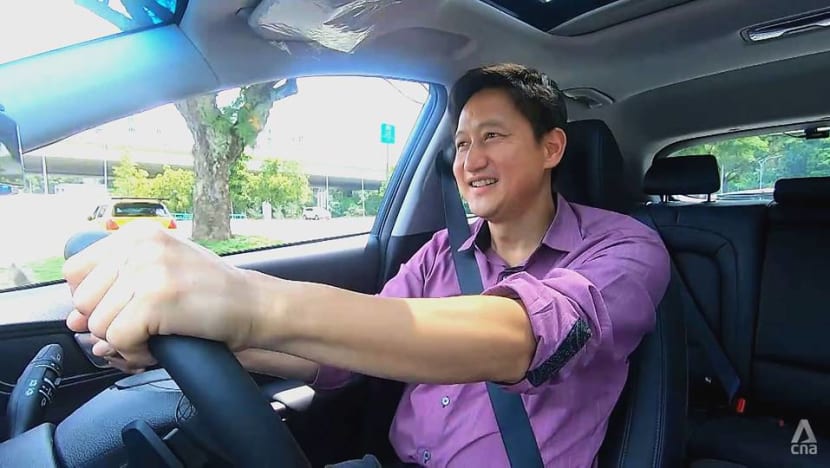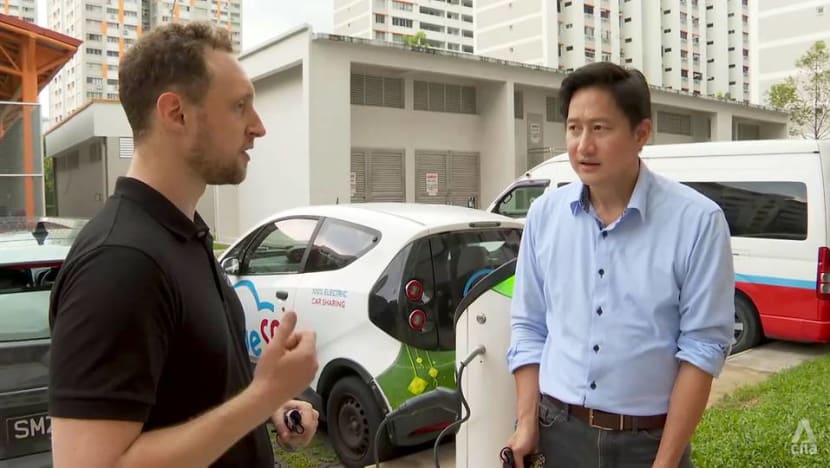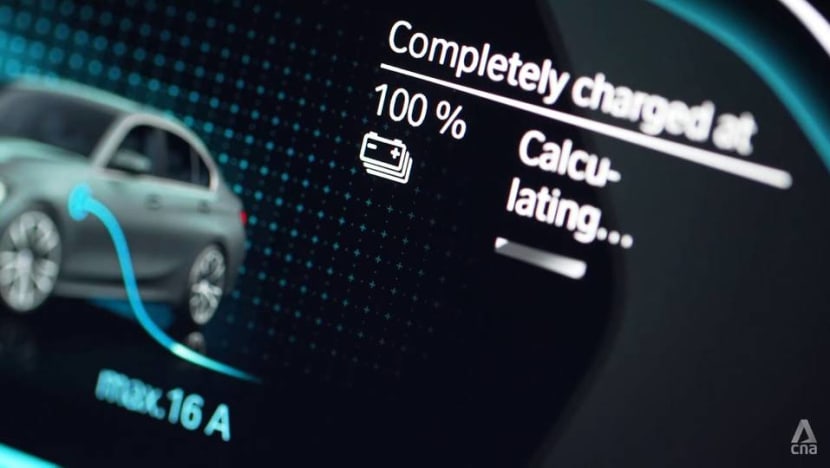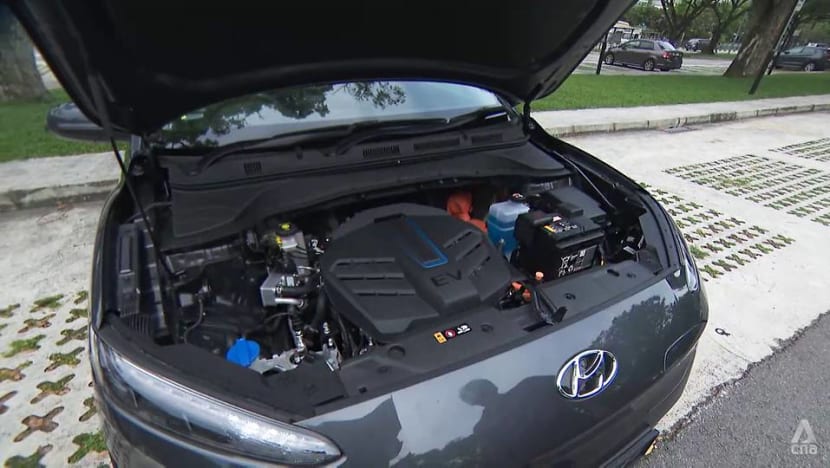Electric vehicles may be fast and low-maintenance, but are they a real climate solution?
Talking Point’s Steven Chia spoke to industry players, hitched a ride in a Tesla Model S and pitted an electric car against a petrol car. Here is what he learnt.

Talking Point host Steven Chia learnt that low-carbon transport is not all about the vehicle per se.
SINGAPORE: Five years after he became the first owner of a Tesla Model S in Singapore, Joe Nguyen still enjoys his electric ride.
It is low-maintenance and cheaper to drive than a petrol car, he said. He spends roughly S$0.06 per kilometre’s drive, compared to about S$0.15 for a typical petrol car. With no carburettor and no transmission because it is single-gear, the car also has fewer moving parts to maintain.
He has not needed to change the brakes in five years because of the Model S’ regenerative braking system, he told Talking Point host Steven Chia.
The programme takes a glimpse at what a switch to electric vehicles (EVs) will mean for Singapore, which plans to phase out vehicles with internal combustion engines by 2040 to improve public health and fight climate change.

There are also lessons to be learned from China, which has made greater strides in low-carbon transport.
CHARGING, FAST AND SLOW
As at May 31, there were 1,485 electric cars and 616 plug-in petrol-electric hybrid cars in Singapore. And for drivers, the biggest difference when they switch to EVs is the need to charge their vehicles.
The Government aims to have 60,000 EV charging points by 2030, of which 40,000 will be in public car parks and 20,000 on private premises — up from 1,800 charging points in the country at the end of last year.
READ: All HDB car parks in at least 8 towns to have electric vehicle charging points by 2025
READ: Amid push for electric vehicles, getting charging points installed in condominiums remains a challenge
This will enable it to cease new diesel car and taxi registrations from 2025 and require all new car and taxi registrations to be of cleaner-energy models from 2030.
WATCH: Electric car vs petrol car: Costs, performance, emissions and range (3:57)
Going by this goal, EV chargers will be deployed in most, if not all, car parks over the next decade, said EV Association of Singapore’s vice-president Paul Welsford.
There will be charging points that offer quick top-ups — what he calls opportunity charging — as well as slower top-ups at places like homes or workplaces where cars remain for hours at a stretch. He calls the latter destination charging.
Fast chargers can now be found at selected Shell stations and take 40 to 50 minutes to juice up a car like Hyundai’s Kona Electric from zero to 80 per cent.
According to Welsford, these rapid chargers are often powered to around 50 kilowatts. Chargers rated up to 350 kW exist in some countries, so there is the potential for higher charging speeds in future — from zero to 80 per cent in 20 to 25 minutes and possibly quicker, he cited.

Rapid direct-current charging is, however, more expensive than slower alternate-current charging. It can cost 10 times more in some cases, he said.
But compared to their predecessors, today’s EVs can run farther before needing a recharge. Chia, who drove about 100 km in the Kona Electric using less than half the battery, found that there was “no real need for range anxiety”.
In China’s Shenzhen, where all public buses and taxis are electric, a fully charged bus can cover up to 300 km — more than enough for a day’s work, said Shenzhen Bus Group’s head of international development, Hallie Liao.
Can the batteries be charged excessively, however, and do they carry a higher risk of catching fire than fossil fuel vehicles?
No, they cannot take more energy than they can store. Welsford said EV batteries have sophisticated battery management systems that communicate with EV chargers to make sure that only the required energy is provided to the car.

“That said, there are best practices when it comes to charging, especially with rapid direct-current charging, where it’s usually best to not charge above 80 per cent as this will help the battery maintain its range better,” he said.
Advances in battery technology are helping to reduce the effects of rapid direct-current charging, he added.
There is currently no evidence indicating that EVs are a higher fire risk, he noted. But it is difficult to make a comparison with fossil fuel cars, mainly owing to a lack of data; EVs represent a small percentage of vehicles globally.
While incidents of EV fires generate more attention, said Welsford, “safety is a core part of EV and battery manufacturers who are always looking to improve their technology — and the battery management systems are there to maintain temperatures and reduce the risks”.

The lithium battery is, however, the most expensive component of an electric car, and EV production volumes are a fraction of petrol vehicles’, said Ong Lay Ling, group managing director of car distributor Eurokars Group. “As a result, they’ve yet to achieve economies of scale.”
So EVs cost more than petrol cars. But with the various incentives and rebates in Singapore, prices can be similar.
For instance, the MG HS, a petrol sport utility vehicle, costs S$130,000 with a Certificate of Entitlement. The MG ZS electric vehicle costs S$129,000 — after factoring in a S$20,000 EV Early Adoption Incentive and a S$25,000 rebate under the Vehicular Emissions Scheme.
READ: Budget 2021: More incentives to encourage early adoption of electric vehicles
READ: After a decade of fits and starts, it’s all systems go for Singapore’s electric vehicle dream
Chia was pleased to know that EVs are also fast and deliver instant torque. In contrast, vehicles with internal combustion engines take time to reach maximum torque, which means they take longer to accelerate.

When he and motoring journalist Sheldon Trollope raced the Kona Electric and the Hyundai Venue, a petrol car, to see which could go from zero to 60 km per hour faster, the Kona Electric won easily.
The latter has 395 Newton-metre of torque while the Venue has about 150 Newton-metre.
“Even if you had a petrol car with the same amount of torque, (the Kona Electric) would have an advantage because it’d (reach) that maximum torque immediately, whereas the petrol car has to build up the (revolutions per minute) and get to that point,” said Trollope.
ELECTRIC VEHICLES' CLIMATE CREDENTIALS
Chia was disappointed to know, however, that the absence of tailpipe emissions did not mean EVs are zero-emission. This is because Singapore generates most of its electricity from natural gas, a fossil fuel that emits carbon when burnt.
WATCH: Episode 1 in full — Switching to electric car: Is it worth it? (22:20)
While natural gas burns more cleanly than coal, drilling and the extraction of the gas causes methane, a heat-trapping gas, to leak into the atmosphere.
Nonetheless, EVs are important in curbing global warming. Recent studies have found that they emit less carbon than fossil fuel cars in their lifetime — more so in countries that generate most of their electricity from renewable energy. They also help reduce choking air pollution, which kills people prematurely.
In Shenzhen, 70 per cent of electricity is from clean sources such as solar and wind, said Liao, whose company generates some of its own power from on-site solar panels.
In one depot, for example, the energy from panels installed there is enough to power six taxis a day. The energy is stored in a battery system fashioned from used bus batteries, allowing taxis to be charged day or night.
WATCH: Solar-powered electric public transport? Shenzhen’s experiment (3:03)
Shenzhen, a city with 12.5 million residents, is also home to BYD, one of the world’s biggest EV makers.
As cities worldwide switch to electric mobility, however, environmentalists have warned of an impending flood of e-waste and the need to recycle disused lithium-ion batteries.
According to advocacy group Greenpeace East Asia’s detox campaigner Zheng Mingyang, more than 12 million tonnes of the world’s EV batteries will be retired by 2030. In China, this figure will hit seven million tonnes over the decade, he said.
In Singapore, e-waste recycler TES has a facility that is also able to extract EV batteries.
Three minerals — lithium, cobalt and graphite — are extracted in TES’ recycling process, said group chief financial officer Diana Ong. They can be used to make new batteries, reducing the need to mine new minerals.

“Our research and development folks are working very hard in terms of tweaking the mechanical and chemical process to … cope with the recycling of EV batteries,” she said. “So in time to come, we’ll … cope with the volume.”
To reduce the carbon footprint of its recycling process, TES has rooftop solar panels connected to its energy storage system, she added.
It is still early days for Singapore’s low-carbon mobility push, but for Chia, it is clear the task is not simple.
“What’s been most eye-opening to me in the search for low-emission transportation is that it doesn’t just start and end with the vehicle,” he said.
WATCH: Episode 2 in full — Electric cars: Can vehicles really be zero-emission? (23:43)
“It’s crucial to also think about what produces the fuel for the vehicles, be that electricity or hydrogen, and what happens to their parts when they’re no longer in use,” he noted.
“The last thing we want is for our greener transport solutions to become the next climate problem.”
Watch these two episodes of Talking Point here and here. The programme airs on Channel 5 every Thursday at 9.30pm.

















